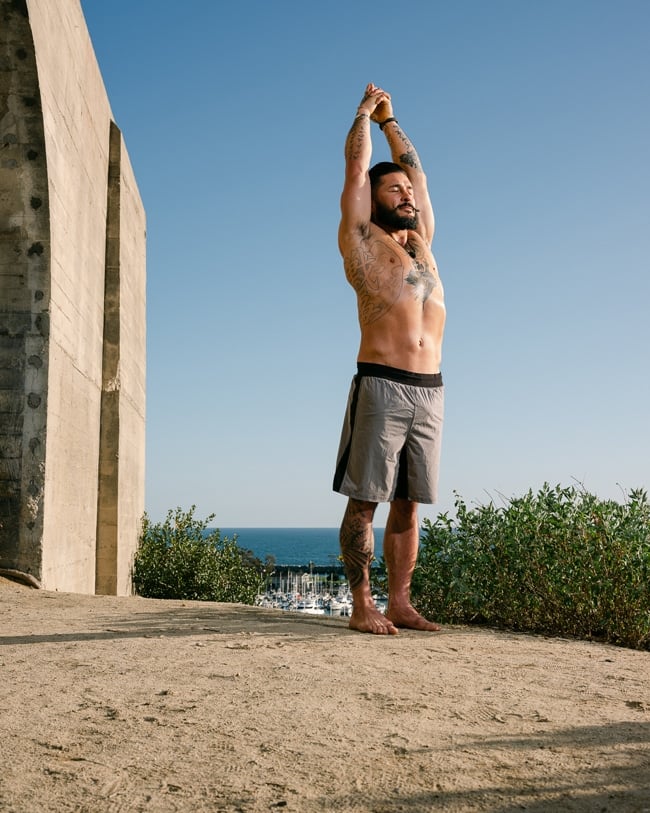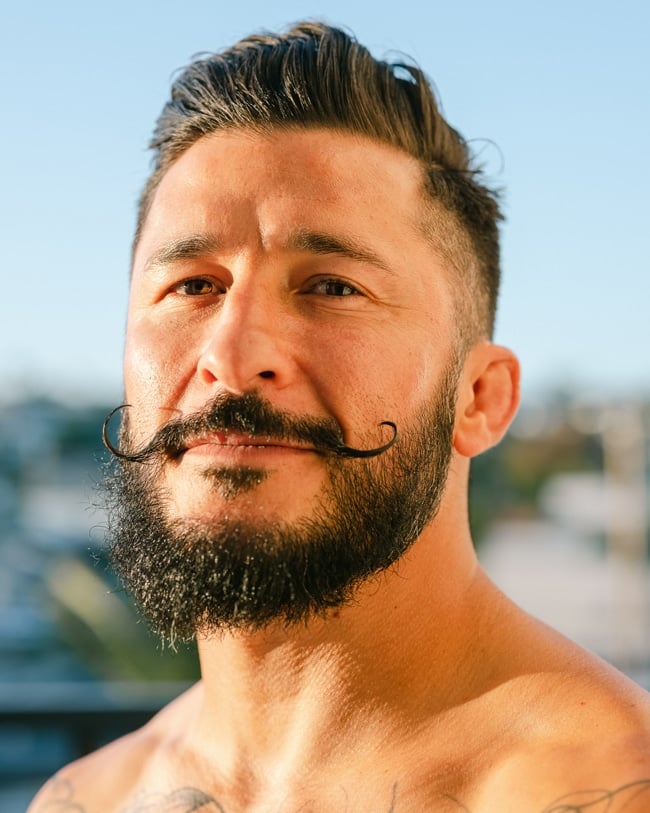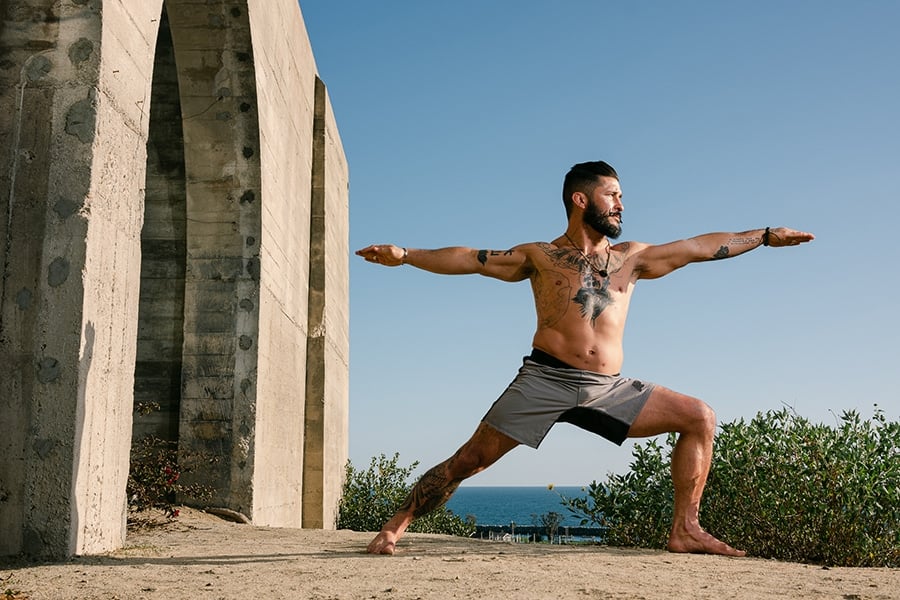Over a quiet Valentine’s Day dinner at home with his 10-year-old daughter London, Ian McCall kept coming back to one nagging thought: He couldn’t remember where he parked his car. A lapse of memory that some would chalk up to simple forgetfulness or a ‘senior moment’ became an increasing source of dread for the former MMA fighter as the evening wore on—a visit from a ghost of an injury past.
“I felt an overwhelming sense of confusion and feeling like I was fucking crazy,” McCall says. “And I know that feeling. I had that for a long time.”
McCall recounts the incident over breakfast at a coffee shop in his hometown of Dana Point, California, as he discusses his 16-year career as a professional fighter—almost half of which was spent competing in the Ultimate Fighting Championship (UFC) league under the moniker “Uncle Creepy.” “It was a wild time,” McCall fondly says of his days in the UFC. “Just traveling the world getting punched in the face for a living.”

But those bouts in the ring took a physical toll on the flyweight champion. McCall endured various injuries—multiple broken bones, seven surgeries to repair tears in his shoulder and hip joints, and numerous concussions that led to the development of symptoms associated with traumatic brain injury (TBI).
Dr. Evan Lewis, a clinical neurophysiologist who heads the Neurology Center of Toronto, says the impact on the brain from blows to the head like the ones McCall suffered are akin to forcefully shaking a delicate snow globe. While concussive episodes may not result in permanent damage to what he calls the physical “hardware” of the brain, the trauma can scramble the “software” our brain uses to make sense of the world.
“You become hypersensitive to everything,” Lewis explains. He says symptoms of mild TBI experienced by athletes can include headaches and dizziness; sensitivity to light and sound; and can lead to cognitive issues like memory loss, depression, and anxiety. “Your thoughts are too much too fast,” Lewis says. “This is because the software in the brain which normally filters out all of the stimuli is not working well.”
READ: 11 Athletes Who Have Praised Psychedelics

McCall turned to various addictive substances to deal with those physical traumas. He says at one point he was snorting painkillers like fentanyl and OxyContin just to get any sense of relief. He also began contemplating a more permanent solution. “I wanted to kill myself,” McCall soberly confesses. “Your body’s just so beat up after training every day, all day. It just hurts.”
The darkness of that moment sits in stark contrast to McCall’s present state of being. After almost two decades of pummeling opponents in the ring and battling his own inner demons, McCall—who calmly sips his Americano after a morning session of beach yoga—says he feels like a reformed man. So what changed?
“I started taking psychedelics for my healing,” McCall states.
After tinkering with cannabis as a pain management tool, McCall began experimenting with “biohacking” his own body—first using peptides and then graduating to various psychedelics like psilocybin and N,N-dimethyltryptamine, known as DMT. He noticed improvements not only in his physical symptoms, but in his mental health as well. “DMT is what made me stop [having suicidal thoughts],” McCall says. “It made me want to not kill myself.”

McCall is part of the first wave of former professional sports stars to advocate for the use of psychedelics to treat and manage the effects of traumatic brain injury. “I started to preach about psychedelics,” McCall says. “I started to educate athletes.”
The issue came to mainstream attention after a 2020 episode of HBO’s Real Sports examined athletes’ use of psychedelics to manage the damage of head trauma suffered throughout their sports careers. In that episode, McCall is seen helping fellow MMA fighter Dean Lister through his first psilocybin trip during a private ceremony with a shaman. As the segment ends, Lister—who confesses that he drank up to 20 beers a day to manage his pain symptoms—tells viewers that he’s been able to steer clear of alcohol and pills after his experience in the jungle.
How to Grow Shrooms Bundle
Take Both of Our Courses and Save $90!
Since that episode aired, a growing number of athletes have come forward with their own experience of using psychedelics to treat TBI-related symptoms. Heavyweight boxing champion Mike Tyson has credited his use of psilocybin in a number of interviews for saving his life and creating a “happier, lighter version” of himself. Sports stars like former NFL safety Kerry Rhodes, NBA Lakers star Lamar Odom, and rugby champion Anna Symonds have also advocated for athletes’ access to these alternative treatments. The anecdotal evidence reported by these athletes reflects emerging research investigating the therapeutic aspects of psychedelics to treat psychological disorders and trauma like depression and post-traumatic stress disorder (PTSD).
READ: Trauma is the New Buzzword, but Does Everyone Really Have It?

“PTSD and TBI often go together,” explains Dr. Berra Yazar-Klosinski, chief scientific officer at MAPS (Multidisciplinary Association for Psychedelic Studies) Public Benefit Corporation. “Because with brain injury, there’s also an emotional impact of that brain injury.” Studies conducted by the Multidisciplinary Association for Psychedelic Studies (MAPS) found MDMA to be effective in treating symptoms of PTSD. Yazar-Klosinski says the organization’s first Phase 3 clinical trial found that 88 percent of participants saw significant reduction in symptoms after just a few sessions of MDMA-assisted therapy; almost two-thirds no longer qualified for a PTSD diagnosis after two months of treatment.
“We found that the most prominent area of reduction in impairment was actually in family life,” Yazar-Klosinski says. “Because [psychedelics] help people to kind of connect better with their families. And there were also improvements in work and social life.”
Researchers at Johns Hopkins Center for Psychedelic and Consciousness Research have also found evidence that psychedelic treatment with psilocybin can help alleviate symptoms in patients suffering from depression, anxiety, and even addiction.
Johns Hopkins research fellow Dr. Manoj Doss explains that psychedelics could work to relieve symptoms of brain injury on a couple of levels. Serotonergic compounds like those found in psilocybin, DMT, lysergic acid diethylamide
(LSD), and ayahuasca could help promote an anti-inflammatory response that would aid the brain in healing and prevent further neural damage. Some early studies also suggest that psychedelics could help with the development
of new neurons, known as neurogenesis, particularly in the hippocampal region of the brain that regulates emotional behavior and memory.
“There’s some evidence that yes, psychedelics might increase neurogenesis,” Doss explains. “But we’re not talking about really large structural changes that you could probably notice with an MRI.”
Lewis concurs with this assessment. He says while early research is showing promise to address a subset of psychological symptoms associated with TBI, we are still in the very early days of understanding how psychedelics work and interact with the brain.
“From a clinical neurology point of view, there’s very little to no research out there for psychedelics,” Lewis says. He compares the current scientific gaps to the early days of cannabis research. “You’ve got this population that’s coming forward, who’s doing psychedelics and feeling better, so everybody is really working on catching up.”
He adds where psychedelics could be beneficial is in targeting the underlying functional neurological disorders—or problems with the brain’s software— that arise in patients with head injury.
“Where psychedelics are going to immediately be helpful is in people’s experience of their illness,” Lewis says. “We may not be able to cure the entire TBI with psychedelics, nor should anybody pretend that’s a realistic goal. But if we can get a portion of the symptomatology under control you can really help a lot of people.”
Psychedelics are also being explored for their performance enhancing capabilities. Journalist James Oroc reported extensively on the 40-year history of LSD and psychedelics in the extreme sports underground. Athletes in that community who took LSD saw that “in many cases cognitive functioning, emotional balance, and physical stamina were actually found to be improved,” Oroc wrote. And Pittsburgh Pirates pitcher Doc Ellis famously admitted that he was under the influence of LSD when he tossed his no-hitter against the San Diego Padres in 1970.
More recently, pro surfer Kelly Slater, who has been outspoken about the dangers of drugs throughout his career, surprised fans when he went public about his experience with ayahuasca. The 11-time world champion called it “one of the most profound experiences” of his life that helped bring clarity to his career and performance.
But Slater is one of the few active athletes to speak candidly of their experience using psychedelics. The fact remains that most psychedelics are still classified as Schedule I substances under federal law and their use is banned by the four major sports leagues in the United States—admitting to their use is confessing to illegal activity that could have professional ramifications.
Psychedelics also come with a certain social stigma that may give elite athletes pause. McCall says this apprehension is common among the athletes he trains as a psychedelic integration coach. “There’s always concern because a lot of people haven’t done psychedelics before,” McCall says. “But this is how you clear the path so your body can perform.”
After retiring in 2018, McCall says his life’s mission is to help others not only perform at a high level, but aid healing in those that have suffered the horrible effects of head injuries.
Last year, UFC executives explored a partnership with Johns Hopkins University to study the use of psychedelic drugs as treatment for brain issues. But that research never moved forward. McCall, who had championed the partnership, said the setback was disappointing, but he remains hopeful that the growing body of evidence supporting the benefits of psychedelics will lead to more academic research related to athletes and TBI.
How to Grow Shrooms Bundle
Take Both of Our Courses and Save $90!
“I was so selfish in my life at one point I became the best in the world,” McCall wistfully says. “My life changed the moment I said, ‘I’m not going to touch anything unless it helps other people.’ And once I put that energy in motion now everything’s working out.”
*This article was originally published in DoubleBlind Issue 7.

DoubleBlind is a trusted resource for news, evidence-based education, and reporting on psychedelics. We work with leading medical professionals, scientific researchers, journalists, mycologists, indigenous stewards, and cultural pioneers. Read about our editorial policy and fact-checking process here.

DoubleBlind Magazine does not encourage or condone any illegal activities, including but not limited to the use of illegal substances. We do not provide mental health, clinical, or medical services. We are not a substitute for medical, psychological, or psychiatric diagnosis, treatment, or advice. If you are in a crisis or if you or any other person may be in danger or experiencing a mental health emergency, immediately call 911 or your local emergency resources. If you are considering suicide, please call 988 to connect with the National Suicide Prevention Lifeline.



